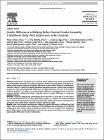| dc.contributor.author | Cosma, Alina | |
| dc.date.accessioned | 2022-07-13T08:56:59Z | |
| dc.date.available | 2022-07-13T08:56:59Z | |
| dc.date.issued | 2022 | |
| dc.date.submitted | 2022 | en |
| dc.identifier.citation | Alina Cosma, Gender Differences in Bullying Reflect Societal Gender Inequality: A Multilevel Study With Adolescents in 46 Countries, Journal of Adolescent Health, 2022 | en |
| dc.identifier.other | Y | |
| dc.identifier.uri | https://www.jahonline.org/article/S1054-139X(22)00463-3/fulltext | |
| dc.identifier.uri | http://hdl.handle.net/2262/100133 | |
| dc.description | PUBLISHED | en |
| dc.description.abstract | Purpose
Social patterns in bullying show consistent gender differences in adolescent perpetration and victimization with large cross-national variations. Previous research shows associations between societal gender inequality and gender differences in some violent behaviors in adolescents. Therefore, there is a need to go beyond individual associations and use a more social ecological perspective when examining gender differences in bullying behaviors. The aim of the present study was twofold: (1) to explore cross-national gender differences in bullying behaviors and (2) to examine whether national-level gender inequality relates to gender differences in adolescent bullying behaviors.
Methods
Traditional bullying and cyberbullying were measured in 11-year-olds to 15-year-olds in the 2017/18 Health Behaviour in School-aged Children study (n = 200,423). We linked individual data to national gender inequality (Gender Inequality Index, 2018) in 46 countries and tested their association using mixed-effects (multilevel) logistic regression models.
Results
Large cross-national variations were observed in gender differences in bullying. Boys had higher odds of perpetrating both traditional and cyberbullying and victimization by traditional bullying than girls. Greater gender inequality at country level was associated with heightened gender differences in traditional bullying. In contrast, lower gender inequality was associated with larger gender differences for cyber victimization.
Discussion
Societal gender inequality relates to adolescents' involvement in bullying and gendered patterns in bullying. Public health policy should target societal factors that have an impact on young people's behavior. | en |
| dc.language.iso | en | en |
| dc.relation.ispartofseries | Journal of Adolescent Health; | |
| dc.rights | Y | en |
| dc.subject | Bullying | en |
| dc.subject | Cyberbullying | en |
| dc.subject | Gender inequality | en |
| dc.subject | Gender | en |
| dc.subject | Victimization | en |
| dc.subject | Perpetration | en |
| dc.subject | Cross-national | en |
| dc.subject | HBSC | en |
| dc.title | Gender Differences in Bullying Reflect Societal Gender Inequality: A Multilevel Study With Adolescents in 46 Countries | en |
| dc.type | Journal Article | en |
| dc.type.supercollection | scholarly_publications | en |
| dc.type.supercollection | refereed_publications | en |
| dc.identifier.peoplefinderurl | http://people.tcd.ie/cosmaa | |
| dc.identifier.rssinternalid | 244550 | |
| dc.rights.ecaccessrights | openAccess | |
| dc.relation.source | Health Behaviour in School-aged Children (HBSC) study | en |
| dc.subject.TCDTheme | Inclusive Society | en |
| dc.subject.TCDTag | Gender inequality | en |
| dc.relation.sourceuri | www.hbsc.org | en |
| dc.identifier.orcid_id | 0000-0002-0603-5226 | |
| dc.subject.darat_thematic | Gender | en |
| dc.subject.darat_thematic | Health | en |
| dc.status.accessible | N | en |




